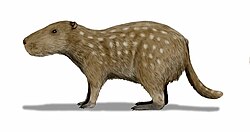This article needs additional citations for verification .(November 2022) |
| Chapattimyidae Temporal range: | |
|---|---|
| Scientific classification | |
| Domain: | Eukaryota |
| Kingdom: | Animalia |
| Phylum: | Chordata |
| Class: | Mammalia |
| Order: | Rodentia |
| Suborder: | Hystricomorpha |
| Superfamily: | Ctenodactyloidea |
| Family: | † Chapattimyidae Hussain et al. 1978 |
| Genera | |
| |
Chapattimyidae is an extinct family of rodent from Asia. [1] According to Fossilworks, it contains two subfamilies and six unplaced genera. [1]
- Subfamily Baluchimyinae Flynn et al. 1986
- Asterattus Flynn and Cheema 1994
- Baluchimys Flynn et al. 1986
- Lindsaya Flynn et al. 1986
- Lophibaluchia Flynn et al. 1986
- Wakkamys Flynn et al. 1986
- Zindapiria Flynn and Cheema 1994
- Subfamily Chapattimyinae Averianov 1996
- Khodzhentia Averianov 1996
- Terrarboreus Shevyreva 1971
- Unplaced genera
- Basalomys Hartenberger 1982
- Birbalomys Sahni and Khare 1973
- Chapattimys Hussain et al. 1978
- Gumbatomys Hartenberger 1982
- Kazygurtia Nessov 1987
- Subathumys Gupta and Kumar 2015














